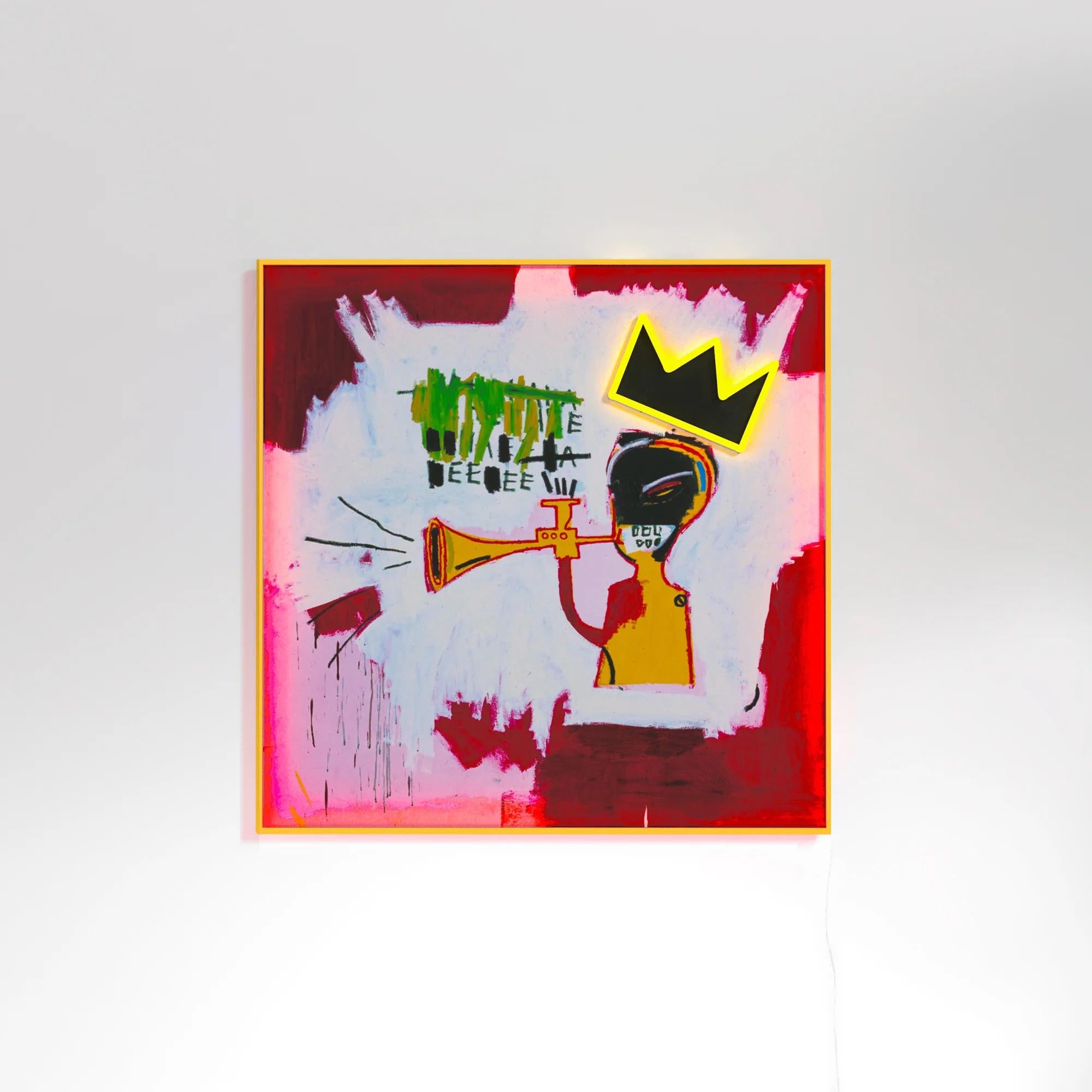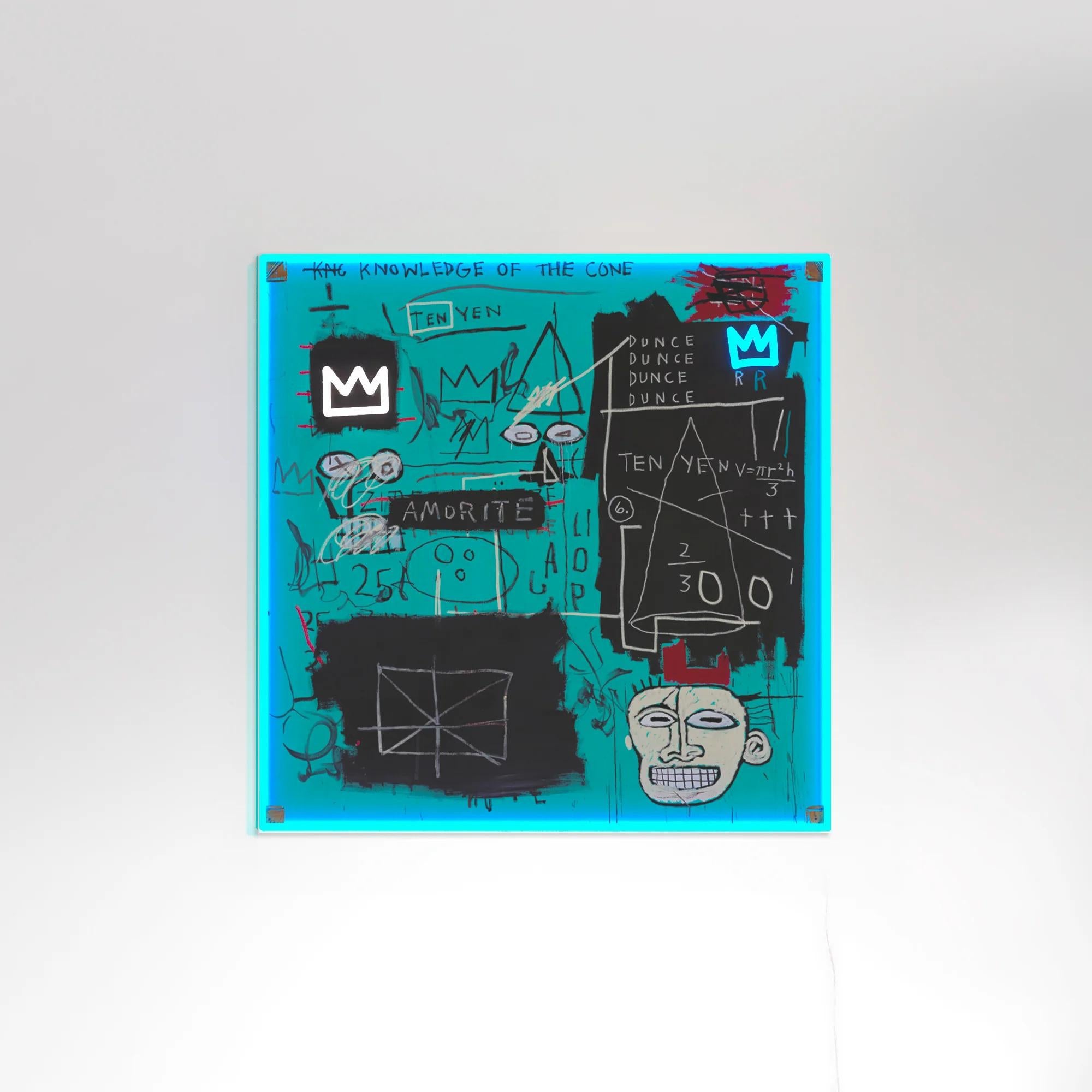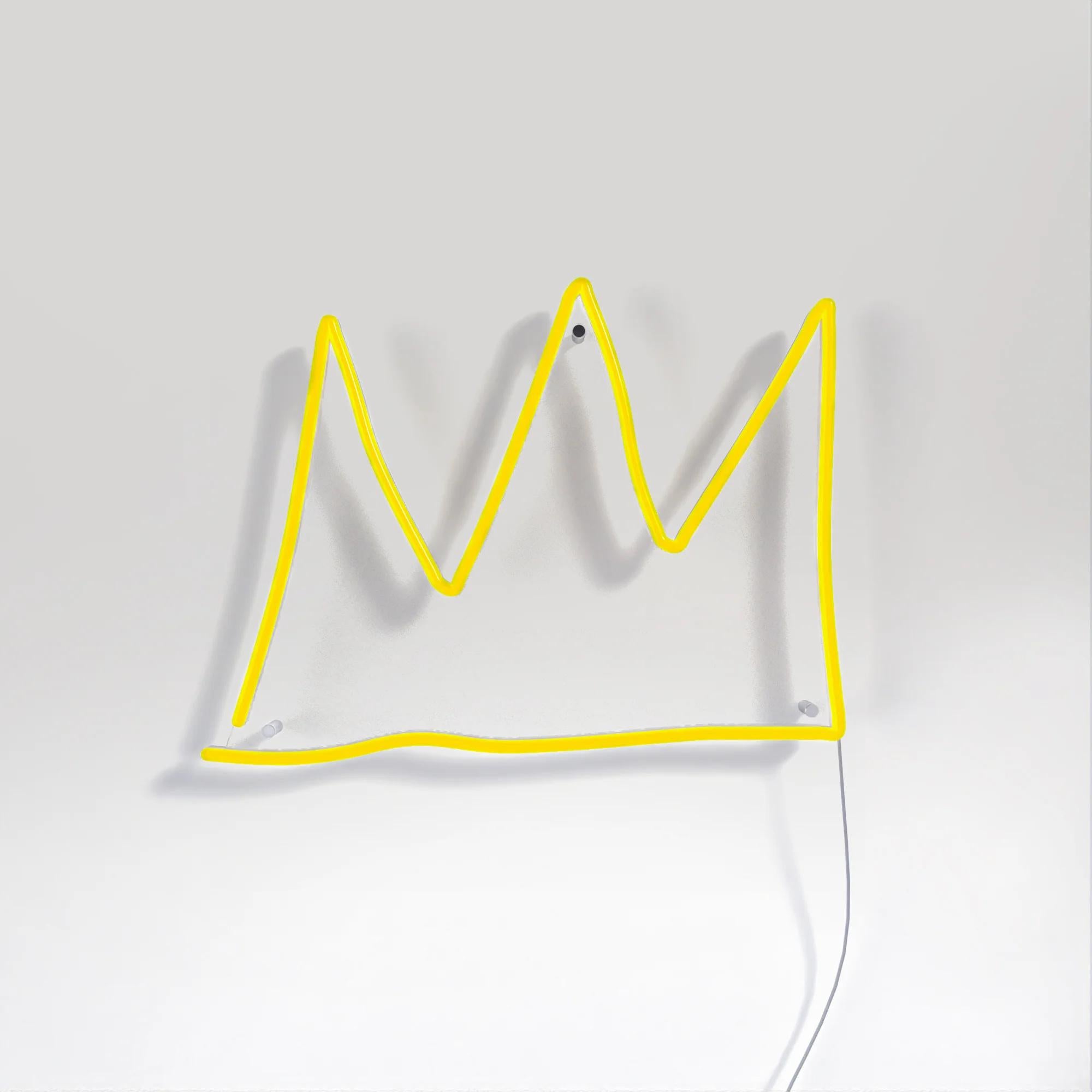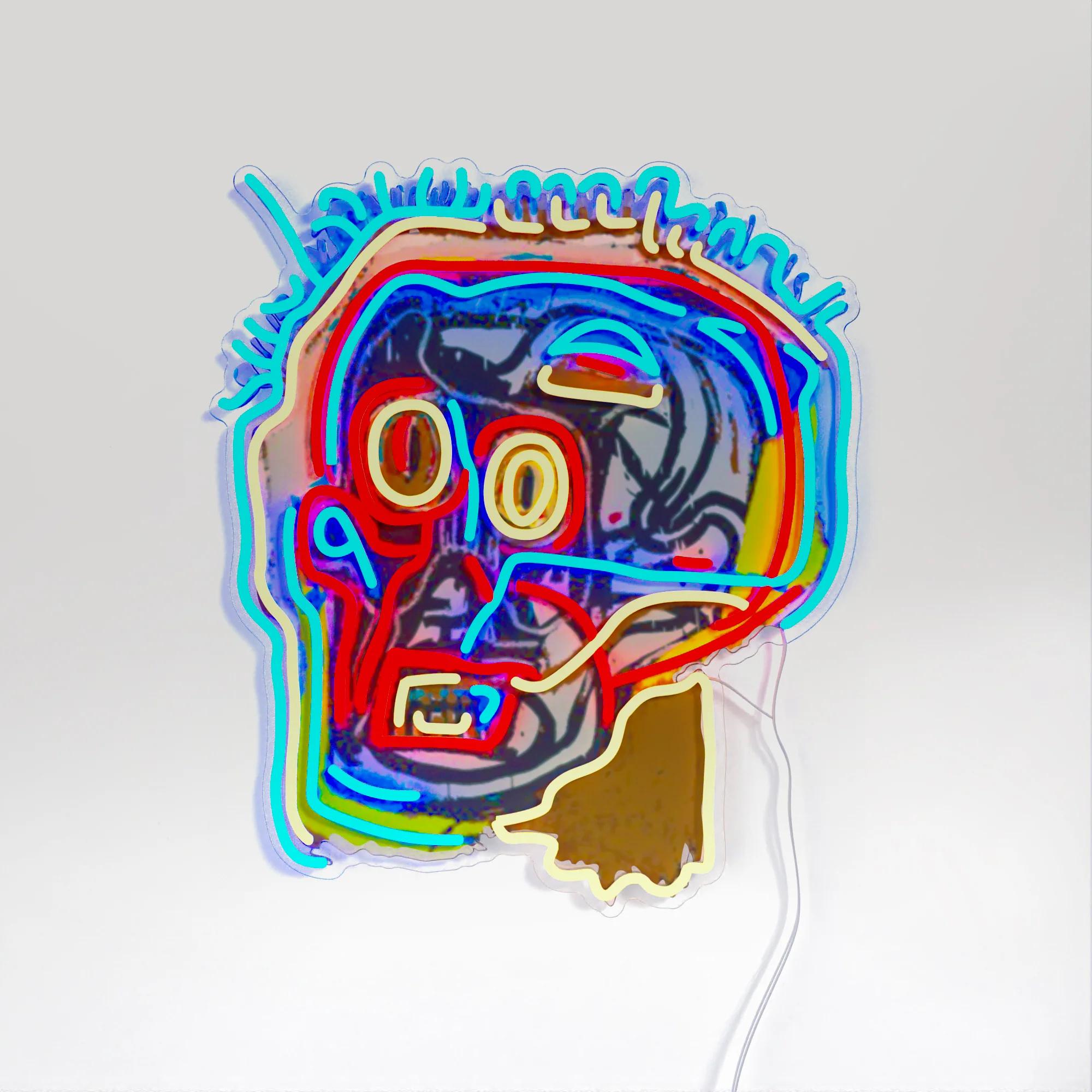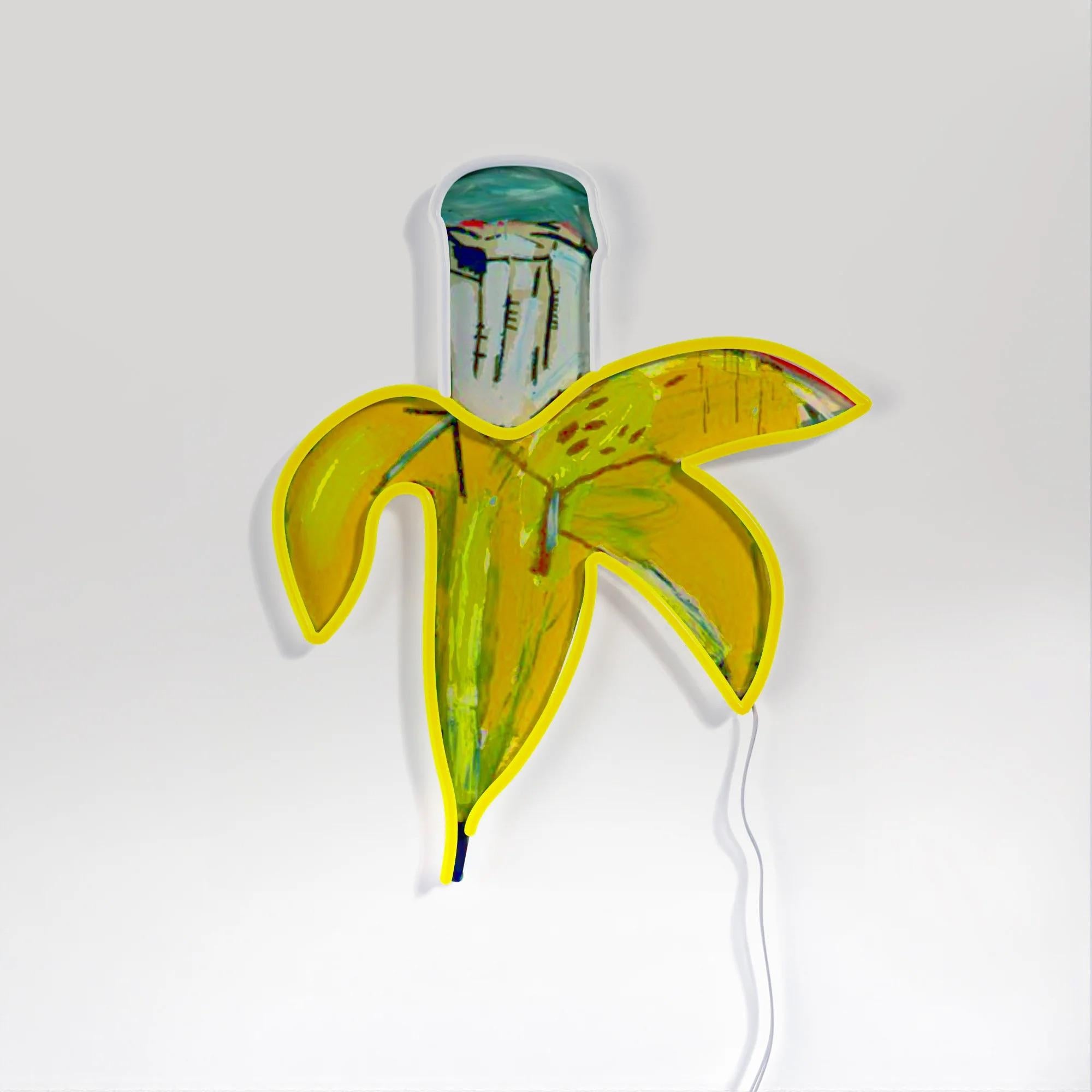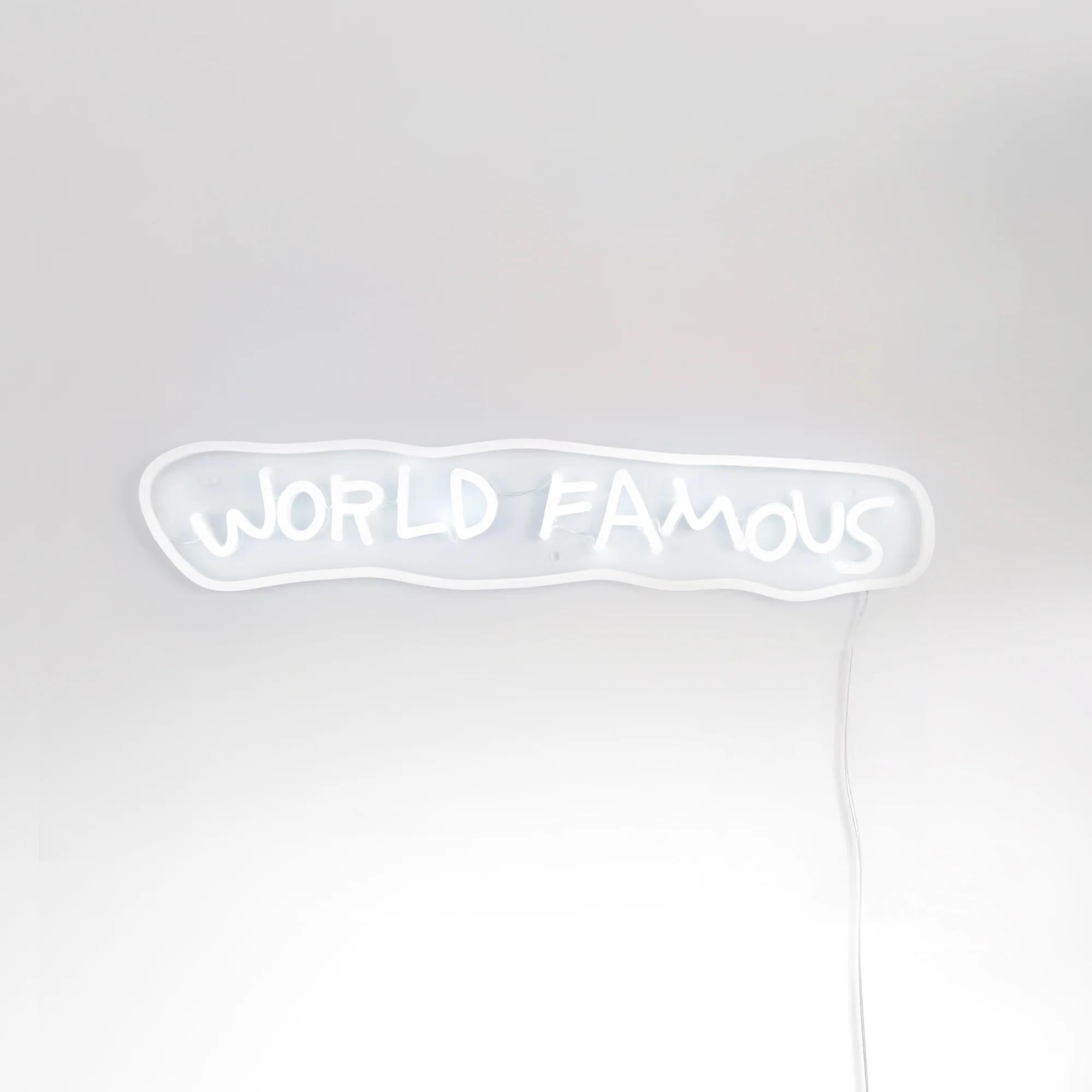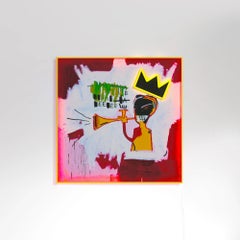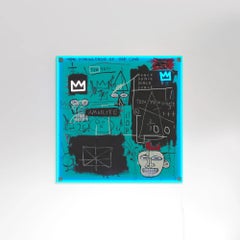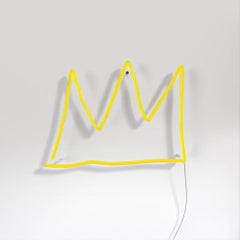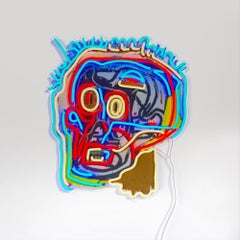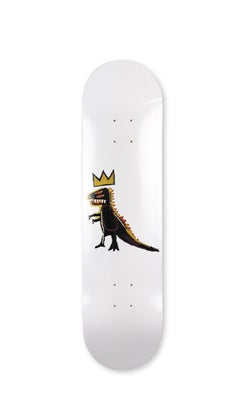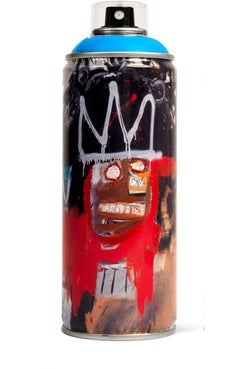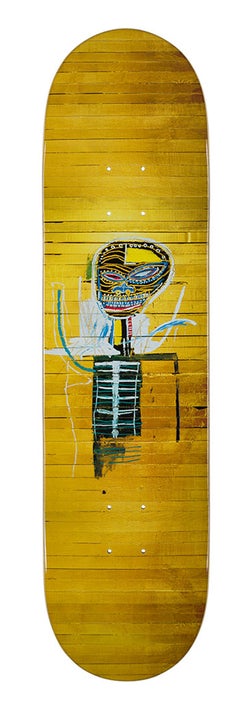Items Similar to Jean-Michel BASQUIAT - PEZ Dispenser YP x JM Basquiat Design Neon LED Lamp
Want more images or videos?
Request additional images or videos from the seller
1 of 5
Jean-Michel BASQUIAT - PEZ Dispenser YP x JM Basquiat Design Neon LED Lamp2024
2024
$687.64
£511.18
€575
CA$959.24
A$1,040.56
CHF 547.18
MX$12,661.49
NOK 6,840.68
SEK 6,451.60
DKK 4,378.97
About the Item
PEZ Dispenser YP x JM Basquiat
Date of creation: 2024
Medium: PVC or Silicon piping with LED lights mounted on recycled acrylic board
Edition: Open
Size: 40 x 50 cm
Condition: Brand new
Jean-Michel Basquiat's PEZ Dispenser fuses an everyday object from popular culture, the PEZ candy dispenser, with symbolism laden with irony and social critique. The dispenser is represented as a dinosaur with a crown, creating a reflection on power, obsolescence and consumption. The figure of the dinosaur, a symbol of extinction, together with the crown, an emblem of authority, represents a power in decline, suggesting that social and political structures could be on the verge of their demise.
The title PEZ Dispenser also plays with child symbolism, alluding to an object associated with amusement and mass consumption, commonly used by children. This reference to the childlike contrasts with the seriousness of the subject that Basquiat explores, creating a duality between light consumption and criticism of the dynamics of power in contemporary society. Thus, the PEZ dispenser becomes a metaphor for systems of power and consumption.
Basquiat uses the image of the crowned dinosaur to question the hierarchies of power and consumerism in modern society. By mixing the childlike with the critical, the work poses a reflection on the obsolescence of old forms of authority and how the systems that sustain them may be destined to disappear, just like the dinosaurs.
The flexible LED tube is safe and environmentally friendly, too! Set the light to the time of day with adjustable brightness.
© Estate of Jean-Michel Basquiat. Licensed by Artestar, New York.
Each sign is made of a neon flex material, consisting of PVC or Silicon piping with LED lights, that is mounted on a recycled acrylic board. These materials allow to create realistic neon signs, with bright lights and intense color, while being more durable, affordable, and sustainable than traditional neon.
Sustainability is taken seriously thanks to its LED lights which consumes 6 times less energy than traditional lights, lasting up to 100,000 hours. These neon is crafted using recycled materials and 100% recycled packaging, including removing all useless plastic.
- Creation Year:2024
- Dimensions:Height: 19.69 in (50 cm)Width: 15.75 in (40 cm)Depth: 1.58 in (4 cm)
- Medium:
- Movement & Style:
- After:Jean-Michel Basquiat (1960 - 1988, American)
- Period:
- Condition:
- Gallery Location:Madrid, ES
- Reference Number:1stDibs: LU1033117016552
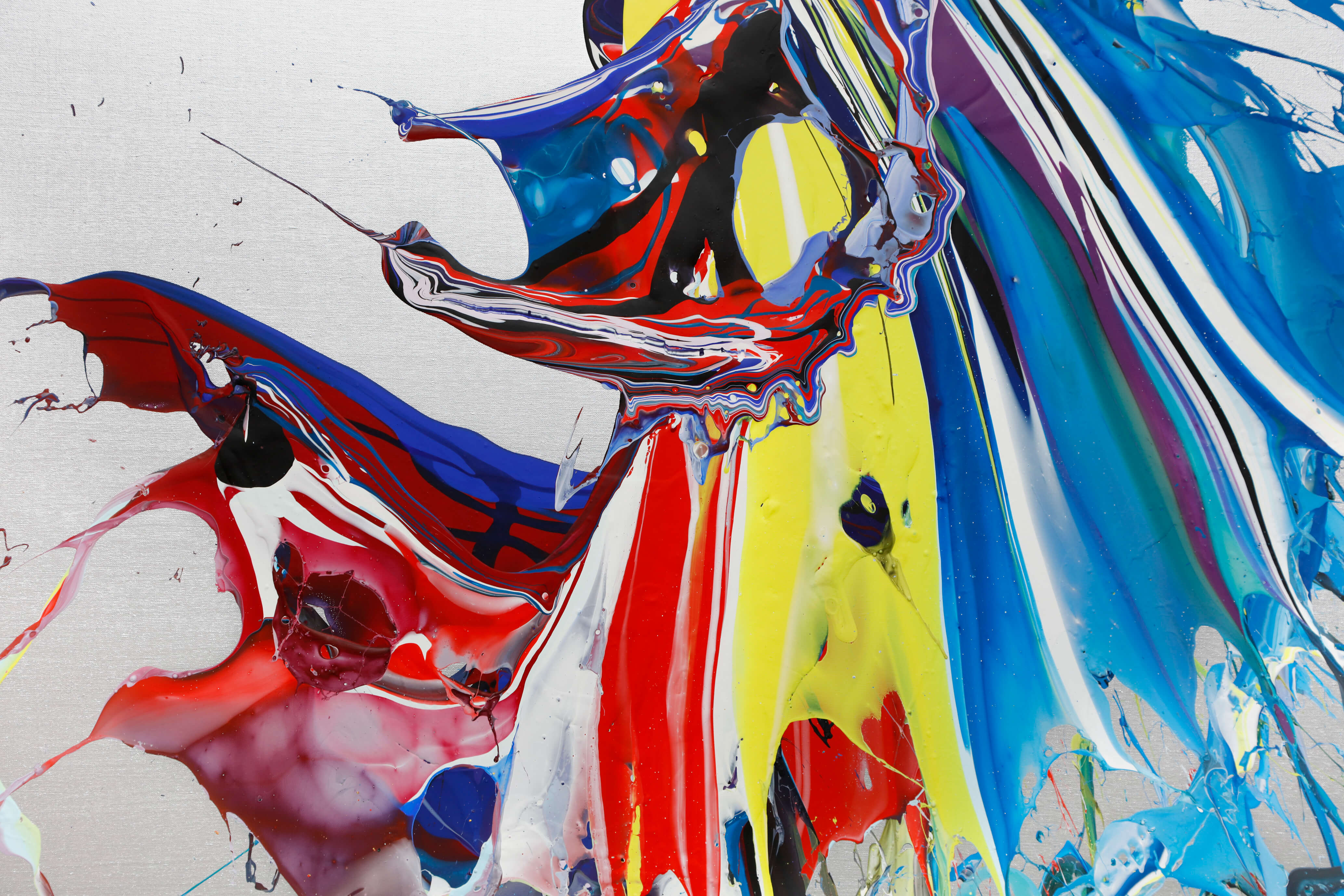
About the Seller
5.0
Gold Seller
Premium sellers maintaining a 4.3+ rating and 24-hour response times
Established in 2011
1stDibs seller since 2018
181 sales on 1stDibs
Typical response time: 13 hours
- ShippingRetrieving quote...Shipping from: Madrid, Spain
- Return Policy
Authenticity Guarantee
In the unlikely event there’s an issue with an item’s authenticity, contact us within 1 year for a full refund. DetailsMoney-Back Guarantee
If your item is not as described, is damaged in transit, or does not arrive, contact us within 7 days for a full refund. Details24-Hour Cancellation
You have a 24-hour grace period in which to reconsider your purchase, with no questions asked.Vetted Professional Sellers
Our world-class sellers must adhere to strict standards for service and quality, maintaining the integrity of our listings.Price-Match Guarantee
If you find that a seller listed the same item for a lower price elsewhere, we’ll match it.Trusted Global Delivery
Our best-in-class carrier network provides specialized shipping options worldwide, including custom delivery.More From This Seller
View AllJean-Michel BASQUIAT - Trumpet Painting YP x JM Basquiat Design Neon LED Lamp
By Jean-Michel Basquiat
Located in Madrid, Madrid
Trumpet Painting YP x JM Basquiat
Date of creation: 2024
Medium: PVC or Silicon piping with LED lights mounted on recycled acrylic board
Edition: Open
Size: 52 x 52 cm
Condition: Br...
Category
2010s Pop Art More Art
Materials
LED Light, Neon Light
Jean-Michel BASQUIAT - Equals Pi YP x JM Basquiat Design Neon LED Lamp. Pop Art
By Jean-Michel Basquiat
Located in Madrid, Madrid
Equals Pi YP x JM Basquiat
Date of creation: 2024
Medium: PVC or Silicon piping with LED lights mounted on recycled acrylic board
Edition: Open
Size: 52 x 52 cm
Condition: Brand new...
Category
2010s Pop Art More Art
Materials
LED Light, Neon Light
Jean-Michel BASQUIAT - The Crown YP x JM Basquiat Design Neon LED Lamp
By Jean-Michel Basquiat
Located in Madrid, Madrid
The Crown YP x JM Basquiat
Date of creation: 2024
Medium: PVC or Silicon piping with LED lights mounted on recycled acrylic board
Edition: Open
Size: 40 x 30 cm
Condition: Brand new...
Category
2010s Pop Art More Art
Materials
LED Light, Neon Light
Jean-Michel BASQUIAT - Untitled (Head) YP x JM Basquiat Design Neon LED Lamp
By Jean-Michel Basquiat
Located in Madrid, Madrid
Untitled (Head) YP x JM Basquiat
Date of creation: 2024
Medium: PVC or Silicon piping with LED lights mounted on recycled acrylic board
Edition: Open
Size: 50 x 58 cm
Condition: Bra...
Category
2010s Pop Art More Art
Materials
LED Light, Neon Light
Jean-Michel BASQUIAT - Banana YP x JM Basquiat Design Neon LED Lamp
By Jean-Michel Basquiat
Located in Madrid, Madrid
Banana YP x JM Basquiat
Date of creation: 2025
Medium: PVC or Silicon piping with LED lights mounted on recycled acrylic board
Edition: Open
Size: 41 x 50 cm
Condition: Brand new
Jean-Michel Basquiat’s banana is a recurring motif in his work that, like many of his symbols, blends humor, irony, and social critique. At first glance, it may seem trivial or even comical, but within Basquiat’s visual language it takes on multiple layers of meaning.
On one hand, the banana works as a pop reference: an everyday object loaded with cultural, sexual, and even absurd connotations, echoing the tradition of pop art and artists like Andy Warhol (who, in 1967, famously turned the banana into an icon with the album cover for The Velvet Underground & Nico). Basquiat, who both admired and collaborated with Warhol, reintroduces the motif in a playful way, but with a more chaotic and visceral energy.
On the other hand, the banana can be read as a critical symbol: it connects to themes of consumerism, exoticization, and racial stereotypes. The tropical fruit evokes colonial imaginaries and the economic exploitation tied to the trade of “exotic” goods in the West. By incorporating it into his work, Basquiat decontextualizes it and turns it into an emblem full of tensions—between comedy and discomfort, pop lightness and historical memory.
Moreover, the way he depicts it —with energetic, almost childlike strokes, scattered words, and graphic marks— enhances the sense of immediacy and freshness, yet behind this apparent spontaneity lies a sharp reflection on identity, power, and contemporary visual culture.
Ultimately, Basquiat’s banana is not just a fruit: it is a visual artifact that fuses humor, irreverence, and social critique, perfectly embodying the artist’s ability to transform the everyday into a biting commentary on the modern world.
The flexible LED tube is safe and environmentally friendly, too! Set the light to the time of day with adjustable brightness.
© Estate of Jean-Michel Basquiat. Licensed by Artestar, New York.
Each sign is made of a neon flex material, consisting of PVC or Silicon piping with LED lights, that is mounted on a recycled acrylic board. These materials allow to create realistic neon signs, with bright lights and intense color, while being more durable, affordable, and sustainable than traditional neon.
Sustainability is taken seriously thanks to its LED lights which consumes 6 times less energy than traditional lights, lasting up to 100,000 hours. These neon is crafted using recycled materials and 100% recycled packaging, including removing all useless plastic.
ABOUT THE ARTIST
Jean-Michel Basquiat (1960-1988) was one of the most influential artists of the 20th century, famous for his ability to fuse urban culture, social criticism and art history into a unique style. Born in Brooklyn, New York, to a Haitian father and Puerto Rican mother, his life and work were shaped by his multicultural heritage, the New York art scene and the social tensions of his time. Although his career was brief, his impact on contemporary art has been lasting and significant.
Basquiat showed an interest in art from an early age. His mother, Matilde Andrades, took him to museums and encouraged him to draw. At the age of seven, a car accident left him hospitalized for a time, and it was then that his mother gave him a copy of the anatomy book Gray's Anatomy, which influenced his fascination with the human body and its visual representation.
Despite his early talent, Basquiat's family life was turbulent. His mother was hospitalized for psychiatric problems and his relationship with his father, Gerard Basquiat, was troubled. This instability contributed to Basquiat dropping out of school at age 17 to pursue his artistic career on the streets of New York.
As a teenager, Basquiat joined the New York graffiti scene under the pseudonym SAMO (an acronym for "Same Old Shit"), which he used to sign his cryptic and poetic messages on the streets of Manhattan with his friend Al Diaz. SAMO's graffiti were a mixture of philosophical and social commentary on popular culture, capitalism and religion, and soon attracted the attention of the underground art scene.
In 1980, SAMO "died" when Basquiat and Diaz decided to end their collaboration, marking the beginning of Basquiat's transition from street graffiti to art galleries.
Basquiat emerged as a talent to watch in 1980, when he participated in the group exhibition The Times Square Show, which included other emerging artists from New York's Lower East Side scene. That same year, he attracted the attention of critics and collectors who saw in his work an electrifying blend of street art and neo-expressionism, the predominant movement of the time.
In 1981, art critic René Ricard published the influential essay The Radiant Child in Artforum magazine, which positioned Basquiat as one of the most promising artists of his generation. Shortly thereafter, he met renowned artist Andy Warhol, with whom he formed a close friendship and significant artistic collaboration. This association was instrumental in catapulting his career into the world of high art.
The collaboration with Warhol was a pivotal point in Basquiat's career. The two artists, although coming from very different worlds, shared a fascination with fame and popular culture. Together, they produced a series of works that combined Warhol's pop art icons with Basquiat's raw, spontaneous style.
However, this collaboration was also a source of controversy. Many critics accused Warhol of "exploiting" Basquiat, while others saw the collaboration as a creative dialogue between two genius minds. Although the criticism was mixed, there is no doubt that the relationship between the two artists helped cement Basquiat's reputation in the art world.
Basquiat's style is a unique amalgam of influences. His work is characterized by the use of dismembered human figures, skeletons and internal organs, evoking the fragility of the body and mortality. Basquiat also used symbols that alluded to African-American and African history, such as crowns, masks and references to historical figures such as Toussaint Louverture.
The use of text is another crucial aspect of his work. Words, phrases and numbers appeared in his paintings, often crossed out or overlapped, creating a sense of controlled chaos. These fragmented words provoked a non-linear reading of his works and conveyed multiple layers of meaning.
His art also reflected his concerns about racial issues, especially the place of people of African descent in Western art history and in society at large. The crowns that Basquiat often drew on his figures were a symbol of power and resistance, a way of proclaiming himself "king" in a world that had historically excluded black artists from the upper echelons of art.
In works such as The Death of Michael Stewart...
Category
2010s Pop Art More Art
Materials
LED Light, Neon Light
Jean-Michel BASQUIAT - World Famous YP x JM Basquiat Design Neon LED Lamp
By Jean-Michel Basquiat
Located in Madrid, Madrid
World Famous YP x JM Basquiat
Date of creation: 2024
Medium: PVC or Silicon piping with LED lights mounted on recycled acrylic board
Edition: Open
Size: 71 x 15 cm
Condition: Brand ...
Category
2010s Pop Art More Art
Materials
LED Light, Neon Light
You May Also Like
Jean-Michel Basquiat - Pez Dispenser (1984)
By Jean-Michel Basquiat
Located in Central, HK
Jean-Michel Basquiat
Pez Dispenser (1984)
Made of 7 ply Grade A Canadian Maple Wood
31 1/2 × 7 9/10 in 80 × 20 cm
Category
2010s More Art
Materials
Wood
Jean-Michel Basquiat Spray Paint Can 2017
By Jean-Michel Basquiat
Located in NEW YORK, NY
Limited edition Jean-Michel Basquiat Spray Paint Can 2017:
Highly collectible limited edition Jean-Michel Basquiat spray paint can by published ci...
Category
2010s Pop Art More Art
Materials
Metal
Basquiat Gold Griot Skateboard Deck (Basquiat skate deck)
By Jean-Michel Basquiat
Located in NEW YORK, NY
Limited edition Basquiat Gold Griot Skateboard Deck c. 2019:
Rare limited edition Basquiat skateboard deck published by The Broad Museum Los Angeles in conjunction with the estate of...
Category
21st Century and Contemporary Pop Art Abstract Prints
Materials
Wood, Offset
Limited edition Basquiat spray paint can 2017 (Basquiat graffiti)
By (after) Jean-Michel Basquiat
Located in NEW YORK, NY
Limited Edition Jean-Michel Basquiat spray paint published circa 2017 featuring the Estate trademark of Jean-Michel Basquiat. a unique Basquiat collectible that makes for a fantastic...
Category
1980s Street Art Prints and Multiples
Materials
Metal
Basquiat Skateboard Deck (Basquiat Toxic)
By Jean-Michel Basquiat
Located in NEW YORK, NY
Jean-Michel Basquiat Skateboard Deck (Basquiat Toxic):
Vibrant, superbly rendered Skateboard Deck licensed by the Estate of Jean Michel Basquiat in conjunction with Artestar, featuring a reproduction of the much iconic 1984 work, Basquiat, “Toxic”.
Medium: Maple Wood with bonded Epoxy Resin. Graphics utilize the multi-media aspects in the artwork, with both single level and raised ink areas.
Dimensions: 31 x 8 inches.
New in original packaging.
Published from an open edition; bold, standout, estate licensed signature on the verso. Licensed by Artestar, NY in conjunction with the Estate of Jean-Michel Basquiat. 2020.
Makes for unique, Basquiat wall art that hangs with ease.
Further background:
Legendary New York graffiti artist, Toxic (Torrick Ablack...
Category
2010s Pop Art More Art
Materials
Epoxy Resin, Wood
Price Upon Request
Jean-Michel Basquiat. Numbered color silkscreen print. 1990s.
Located in Saint-Ouen, FR
Jean-Michel Basquiat
Color silkscreen print in its light oak frame.
It is numbered 20/100 and bears the dry stamp of the publisher Rupert Jason Smith (who was Andy Warhol’s printer...
Category
Late 20th Century Prints
Materials
Oak
